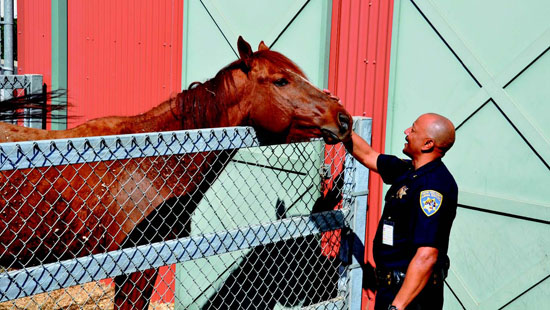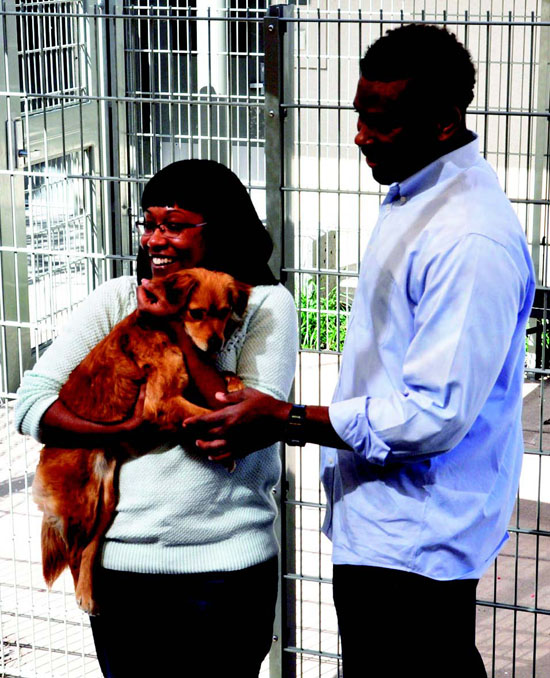 | | | Deputy director Rick Golphin comforts Chewy, impounded due to abuse and neglect. Photo Andy Scheck | | | | | | One by one the women walked to the dais. Each woman, an animal rights advocate or a volunteer at the Martinez animal shelter, lashed out at the Board of Supervisors over the performance and the direction of the Contra Costa County Animal Services Department. They demanded that the county hire a proactive director, and that the director employ No Kill methods and put greater efforts into marketing and public education.
 "The next time you walk through our shelter, look into the animals' eyes," volunteer Debbie Rodriguez told the supervisors at that December meeting. "They're counting on us humans to use our brains and creativity to get them out alive."
"The next time you walk through our shelter, look into the animals' eyes," volunteer Debbie Rodriguez told the supervisors at that December meeting. "They're counting on us humans to use our brains and creativity to get them out alive."
 "Things sometimes don't move quickly enough for them," said Cindy Smith, volunteer program manager, though she acknowledged some of the volunteers' complaints, including the lack of marketing, the difficulty navigating the department website and the need for more public service announcements.
"Things sometimes don't move quickly enough for them," said Cindy Smith, volunteer program manager, though she acknowledged some of the volunteers' complaints, including the lack of marketing, the difficulty navigating the department website and the need for more public service announcements.
 "We've come a long way since 2005, when we moved into this new building," said Smith. "We do have a Facebook presence, Instagram is coming, and we'll be getting a new adoption truck." She stressed the need to do a better job of telling people about adoption. "Because as long as people bring us animals, and pass up animals for adoption, our euthanasia rate will be difficult to drop."
"We've come a long way since 2005, when we moved into this new building," said Smith. "We do have a Facebook presence, Instagram is coming, and we'll be getting a new adoption truck." She stressed the need to do a better job of telling people about adoption. "Because as long as people bring us animals, and pass up animals for adoption, our euthanasia rate will be difficult to drop."
 Not so, says Stefani Buzzard, president of No Kill Contra Costa, an advocacy group critical of the operation of the Martinez shelter. "It's a conveyor belt to death," she said.
Not so, says Stefani Buzzard, president of No Kill Contra Costa, an advocacy group critical of the operation of the Martinez shelter. "It's a conveyor belt to death," she said.
 Buzzard prefers the county hire a director who is not entrenched in the traditional shelter model. She would like the director to comprehensively implement the No Kill equation, which includes reducing the number of animals coming into the shelter, improving the care of animals at the shelter and increasing the number of positive outcomes. "A 90 percent save rate is realistic," she said, referring to the percentage of shelter animals adopted, returned to their owners or acquired by rescue groups, or neutered and released, as with feral cats.
Buzzard prefers the county hire a director who is not entrenched in the traditional shelter model. She would like the director to comprehensively implement the No Kill equation, which includes reducing the number of animals coming into the shelter, improving the care of animals at the shelter and increasing the number of positive outcomes. "A 90 percent save rate is realistic," she said, referring to the percentage of shelter animals adopted, returned to their owners or acquired by rescue groups, or neutered and released, as with feral cats.
 She outlined some of the programs she would implement to achieve that rate. "Double the number of volunteers," said Buzzard. "Make the animals more adoptable with better training. More public outreach. And build better relationships with rescue organizations."
She outlined some of the programs she would implement to achieve that rate. "Double the number of volunteers," said Buzzard. "Make the animals more adoptable with better training. More public outreach. And build better relationships with rescue organizations."
 Nathan Winograd, director of the Oakland-based No Kill Advocacy Center, noted that the Austin, Texas public shelter, serving a population similar in size to Contra Costa County, with an intake of 18,000 animals a year, reports a 90 percent save rate. "It's because of the decisions made by the people running it," he said. He stressed the need for the department to be proactive with the public, especially at the time of intake. "Before accepting a surrender, ask what the problem is," said Winograd. "It may be a problem that can be fixed."
Nathan Winograd, director of the Oakland-based No Kill Advocacy Center, noted that the Austin, Texas public shelter, serving a population similar in size to Contra Costa County, with an intake of 18,000 animals a year, reports a 90 percent save rate. "It's because of the decisions made by the people running it," he said. He stressed the need for the department to be proactive with the public, especially at the time of intake. "Before accepting a surrender, ask what the problem is," said Winograd. "It may be a problem that can be fixed."
 "The No Kill movement says there is a home for every animal," said Noell Crosse, Animal Services humane education coordinator. "I agree with the No Kill frustration, that no healthy or treatable animal should die. But what is healthy and treatable? If a dog stops eating, starts biting the walls, rescue groups don't want it. I don't know what the answer is."
"The No Kill movement says there is a home for every animal," said Noell Crosse, Animal Services humane education coordinator. "I agree with the No Kill frustration, that no healthy or treatable animal should die. But what is healthy and treatable? If a dog stops eating, starts biting the walls, rescue groups don't want it. I don't know what the answer is."
 Crosse pointed to the importance of public education. "We're not a petting zoo," she said. "Call us what we really are: the dog pound. I want people to know that this is not the place to send their animals. A life in a shelter is not the life that animals were meant to lead."
Crosse pointed to the importance of public education. "We're not a petting zoo," she said. "Call us what we really are: the dog pound. I want people to know that this is not the place to send their animals. A life in a shelter is not the life that animals were meant to lead."
 "Our field staff takes every opportunity to support citizens' maintaining their pets as opposed to surrendering them," said deputy director Rick Golphin. But he explained that the department cannot turn away animals, with pit bull and Chihuahua breeds totaling nearly 50 percent of the dog intake. Those breeds are rarely accepted by rescue groups.
"Our field staff takes every opportunity to support citizens' maintaining their pets as opposed to surrendering them," said deputy director Rick Golphin. But he explained that the department cannot turn away animals, with pit bull and Chihuahua breeds totaling nearly 50 percent of the dog intake. Those breeds are rarely accepted by rescue groups.
 "The most successful shelters have a major partner to address that group of animals that the rescue groups don't take," said Golphin, highlighting the Reno shelter, which teams with the Nevada Humane Society to assist with adoptions. "I prefer to stay away from terms like No Kill," he said. "Just do the best job that you can do."
"The most successful shelters have a major partner to address that group of animals that the rescue groups don't take," said Golphin, highlighting the Reno shelter, which teams with the Nevada Humane Society to assist with adoptions. "I prefer to stay away from terms like No Kill," he said. "Just do the best job that you can do."
 The Animal Services department is charged with both protecting the public and taking care of animals as humanely and ethically as possible. A staff of 78, including veterinary technicians, field officers and administration, plus over 250 volunteers, carry out the department responsibilities from a 38,000 square foot center in Martinez and a satellite shelter in Pinole. Animal Services reported a 2014 intake of 11,000 cats and dogs, down from 15,000 five years ago, along with a save rate of 69 percent last year, up from 59 percent in 2010. "We deal with a serious animal overpopulation, and we have got to stop society from looking at animals as disposable commodities," said Glenn Howell, who retired in January after managing the department for 11 years.
The Animal Services department is charged with both protecting the public and taking care of animals as humanely and ethically as possible. A staff of 78, including veterinary technicians, field officers and administration, plus over 250 volunteers, carry out the department responsibilities from a 38,000 square foot center in Martinez and a satellite shelter in Pinole. Animal Services reported a 2014 intake of 11,000 cats and dogs, down from 15,000 five years ago, along with a save rate of 69 percent last year, up from 59 percent in 2010. "We deal with a serious animal overpopulation, and we have got to stop society from looking at animals as disposable commodities," said Glenn Howell, who retired in January after managing the department for 11 years.
 Howell, rehired as interim director, encouraged the incoming director to be open and to keep up the positive momentum. "We do many things very well," he said. "Our highly regarded medical program is second to none. And I'm proud of our expanded field service."
Howell, rehired as interim director, encouraged the incoming director to be open and to keep up the positive momentum. "We do many things very well," he said. "Our highly regarded medical program is second to none. And I'm proud of our expanded field service."
 County administrator David Twa and the human resources department continue to vet applicants for Animal Services director. "There are no set criteria," said Twa. "We've received applications from a wide range of candidates who embrace diverse approaches to animal services." He also stressed the need for increased public education and outreach, a standard agreed upon by nearly every person interviewed for this article.
County administrator David Twa and the human resources department continue to vet applicants for Animal Services director. "There are no set criteria," said Twa. "We've received applications from a wide range of candidates who embrace diverse approaches to animal services." He also stressed the need for increased public education and outreach, a standard agreed upon by nearly every person interviewed for this article.
 "If Contra Costa County hires the right director who, rather than blaming the public, engages the public, the department will succeed," said Winograd.
"If Contra Costa County hires the right director who, rather than blaming the public, engages the public, the department will succeed," said Winograd.

|

